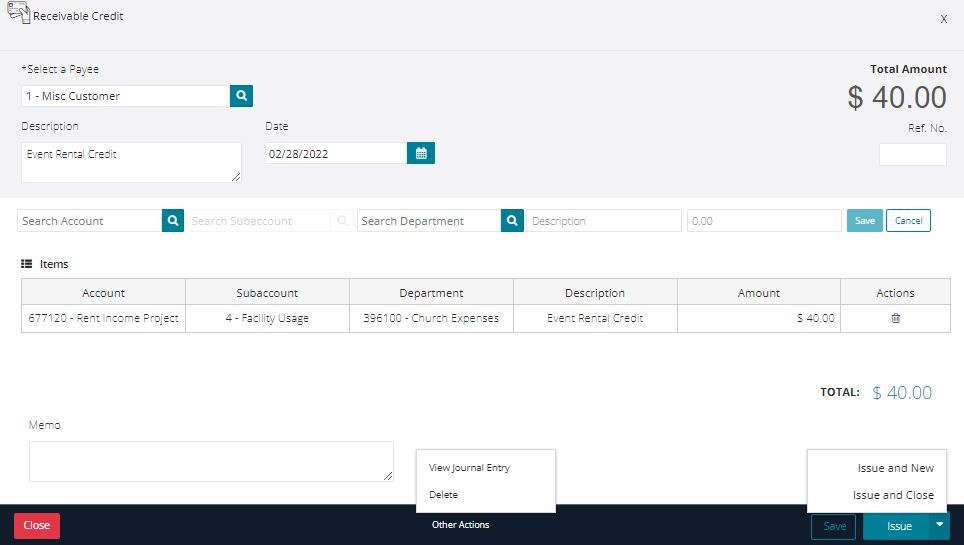In Payable and Receivable you can complete several processes including Enter Bills (Payables), Add Payable Credits, Pay Bills, Create Invoices (Receivables), and Add Receivable Credits. This screen will also display the transactions that you have processed through as Payables and Receivables for you to review and edit as needed.

The pencil icon under the Actions column for each of the entries can be used to reopen each screen and this allows us to view, edit (as long as the entry is not finalized), or use the Other Actions menu (within each screen) to print the journal entry, void, or use the other menu options that are available after an entry is finalized.

In the filter menu, you can set a date and search by entry type (Payable, Receivable, Payable Credit, Receivable Credit), reference code, payee, status (Open, Issued, Void), and Document Type (Invoice, Memo). The clear button will remove any recent selection made in the filter fields and the apply button will run the search including any changes made to the filter and display any findings in the grid view.

You can print or download a list of payables and receivables using the printer or excel icons on the right above the grid view. This will print or download only the entries displayed on the grid view.

The grid view will by default display the first 15 entries and any additional entries will display in separate pages. There is a count for how many entries/items are available and how many are being displayed on the page out of those available. The arrows can be used to move between the pages.
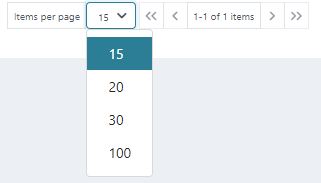
In the Enter Bill (Payable) screen, we will enter the bill/invoice related information for a bill we owe.

We will select the Payee (from a list of Employee, Entity, and Vendors), populate the Invoice Date, Due Date, Invoice No. (bill #), and Bill Description. We will also select the general ledger account to post to which would typically be an expense account for a bill (an account that starts with an 8xxxxx or 9xxxxx), the sub-account (breakdown within the account like an entity or project for example), department, populate a description (which can be the same as the Description at the top of the screen or it can be different if needed or if there are multiple entries), and amount. The Save button after the amount saves the accounting entry and Cancel will clear the current accounting entry. Once the entry is saved, you can add more accounting entries if needed and we may do this if we want to split out the charges into separate expense accounts or just to have them listed individually. There is a trash bin icon under the Actions column next to the accounting entry and this will allow us to delete the accounting entry. There is a Memo field at the bottom of the screen that can be used to add an additional note. In the Other Actions menu at the bottom of the screen, we will see an option to “View Journal Entry” which will give us a printout of the entries related to the Bill and we will see a “Delete” option which will allow us to delete the bill before it is finalized. We will use the “Register and New” button if we are ready to finalize the Bill, the system will save the bill entry, close the current bill, and load a new screen to enter another bill. The “Register and Close” button will save the bill entry, close the current bill, and take us back into the main Payable and Receivable screen and the bill should load in the grid view. The “Register” button will save the bill entry but will leave the Enter Bill (Payable) screen open for the current bill and the “Save” button will save our work in the current bill entry without yet finalizing it and this will allow us to close the bill and come back to edit it later. The “Close” button will close out of the bill entry, but we would want to ensure that we save our work if needed otherwise any recent changes will be lost and the system will prompt us before closing if we are sure we want to close the current window. The system will save the entry we made to the expense account in our example as debit and internally it will make the appropriate offsetting credit entry on our behalf to the accounts payable account based on the selected payee/subaccount (Employee, Entity, or Vendor) and establish a balance due for this payee. Reference Transaction Config and see journal entry example below.
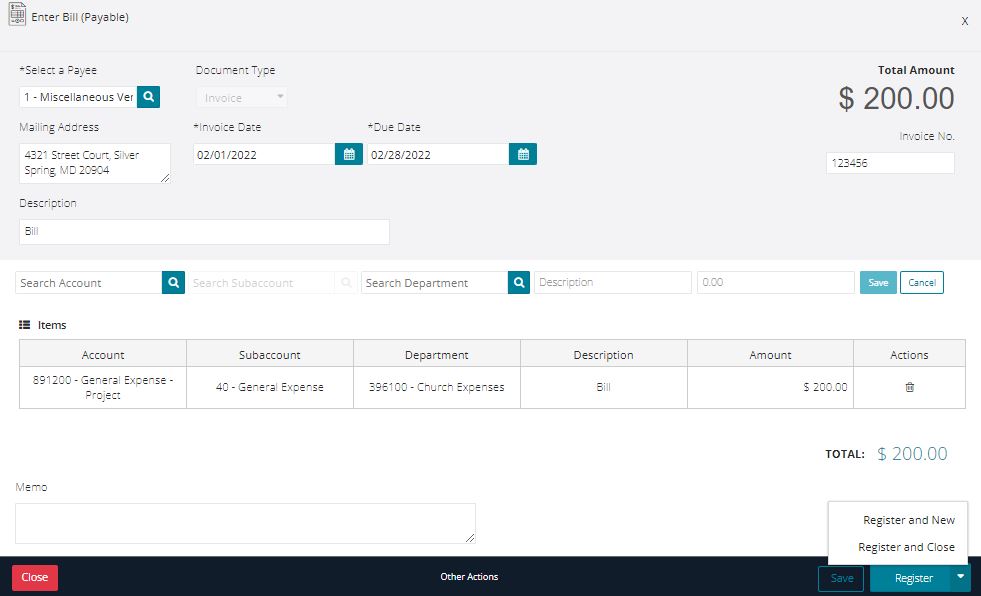

In the Add Payable Credit screen, we will enter credits to a bill which reduces what is owed.

We will select the Payee (from a list of Employee, Entity, and Vendors), populate the Date, Ref. No. (bill #) and Description. We will also select the general ledger account to post to which would typically be an expense account for a payable credit (an account that starts with an 8xxxxx or 9xxxxx) to reduce the expense from the initial bill, the sub-account (breakdown within the account like an entity or project for example), department, populate a description (which can be the same as the Description at the top of the screen or it can be different if needed or if there are multiple entries), and amount. The Save button after the amount saves the accounting entry and Cancel will clear the current accounting entry. Once the entry is saved, you can add more accounting entries if needed and we may do this if we want to split out the credit into separate accounts or just to have them listed individually. There is a trash bin icon under the Actions column next to the accounting entry and this will allow us to delete the accounting entry. There is a Memo field at the bottom of the screen that can be used to add an additional note. In the Other Actions menu at the bottom of the screen, we will see an option to “View Journal Entry” which will give us a printout of the entries related to the payable bill credit and we will see a “Delete” option which will allow us to delete the payable credit before it is finalized. We will use the “Issue and New” button if we are ready to finalize the payable credit, the system will save the payable credit entry, close the current bill credit, and load a new screen to enter another payable credit. The “Issue and Close” button will save the payable credit entry, close the current bill credit, and take us back into the main Payable and Receivable screen and the payable credit should load in the grid view. The “Issue” button will save the bill entry but will leave the Payable Credit screen open for the current payable credit and the “Save” button will save our work in the current payable credit entry without yet finalizing it and this will allow us to close the payable credit and come back to edit it later. The “Close” button will close out of the payable credit entry, but we would want to ensure that we save our work if needed otherwise any recent changes will be lost and the system will prompt us before closing if we are sure we want to close the current window. The system will save the credit entry we made to the expense account in our example and internally it will make the appropriate offsetting debit entry on our behalf to the accounts payable account based on the selected payee/subaccount (Employee, Entity, or Vendor) and reduce the payable amount for this payee. Reference Transaction Config and see journal entry example below.


In the Pay Bills screen, we will select from a list of bills and payable credits to issue payment.

We will select the payee, the bank account that we are issuing the payment from, payment date (for check payments this will be the check date), and payment method (Check, ACH, or Other). We will see displayed a “Balance” and this is populated with a balance amount for the selected bank account to give us a quick view of what is available for us as we issue payments. We can populate a mailing address (for check payments this address will print on the check) and populate a description. The Payment No. (check number for example) will auto populate for us when the payment is issued and can be left blank, but we can also override this field to change the payment number. In the Bills section we can select from the list of bills, and we can also select any payable credits from the AP Credit Memos section. Each section will total up the amount of the entries we have selected as “Total Selected” and the “Payment Total” on the top right of the screen will display the net amount of bills and credits and this is the amount that will be issued on the payment. There is a Memo field towards the bottom of the screen that can be used to add an additional note. The “Pay and Close” button will issue the payment, close the pay bills screen, and take us back into the main Payable and Receivable screen and the bill and payable credit should now display as “Paid”, also a payment entry will be created but will be available in the grid view section of the “Banking Transaction” screen. The “Pay” button will issue the payment but will leave the Pay Bills screen open for the current payment. The “Close” button will close out of the Pay Bills screen, but the system will prompt us before closing if we are sure we want to close the current window. Once payment is issued, the system will save the payment information, make entries to clear the payable balance for the payee (debit entry to the accounts payable account), and internally it will make the appropriate offsetting credit entry on our behalf to the bank account (checking account for example). Reference Transaction Config and see the Journal Entry example below.

After payment is issued, an “Other Actions” section will become available in the Pay Bills screen, and this will allow us to View Journal Entry, Void, and Delete. The View Journal Entry option will display the journal with the entries related to the payment which are the debit to the payable accounts and credit to the bank account. The Void option will allow us to void the payment and will create additional entries for us to void, which will credit back into the payable account and debit the payment amount back into the bank account and a “Void” watermark will display on the check printout, and the payment entry in Banking Transaction will change the status from Issued to Voided and the amount will display as 0.00. After the void, the preview of the check will be marked as voided from the Print Checks screen and Issued Check Report. We can also run a General Ledger or Journal Report to view the voided entries. See example of voided check in the Print Checks screen of Banking Transaction. The Print option will print a document for the payment (if a check is issued, the print button will print the check). The check will also be available to print from the Banking Transaction screen in Print Checks.



In the Pay Bills screen there are three payment method options: Check, ACH, and Other. The default payment method is check and we will see this option selected in Pay Bills. The check payment method will issue a check that can be printed (there is an example above of the check prinout). The ACH process works like issuing a check but instead the ACH entry would be available for us to download into a text file then we can submit it to the bank, and we would be able to print an ACH Slip that can be provided to the payee. The Other payment method allows us to select from Cash, Check, Electronic, and Other as the payment methods and this allows us to record payments that may be processed through these other methods.

The filters in the Bills and AP Credit Memos section of the Pay Bills screen can be used to search by Bill Number, Date, and Overdue Bills Only.

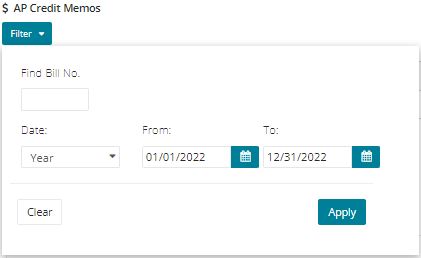
In the Create Invoice (Receivable) screen, we will enter charges to set up an invoice for money we are owed.

We will select the Payee (from a list of Customer, Employee, and Entity), populate an Invoice Date, Due Date (this will tell the payee when their payment is due to us), mailing address (this address will print on the invoice), and Invoice Description. The Invoice No. will auto populate for us when the Invoice is issued and can be left blank, but we can also override this field to assign a different invoice number. We will also select the general ledger account to post to which would typically be an income account when we are invoicing (an account that starts with a 6xxxxx or 7xxxxx), the sub-account (breakdown within the account like a bank, entity, or project for example), department, populate a description (which can be the same as the Description at the top of the screen or it can be different if needed or if there are multiple entries), and amount. The Save button after the amount saves the accounting entry and Cancel will clear the current accounting entry. Once the entry is saved, you can add more accounting entries if needed and we may do this if we want to split out the charges into separate income accounts or just to have them listed individually. There is a trash bin icon under the Actions column next to the accounting entry and this will allow us to delete the accounting entry. There is a Memo field at the bottom of the screen that can be used to add an additional note. In the Other Actions menu at the bottom of the screen, there is an option to “View Journal Entry” which will give us a printout of the entries related to the invoice being created, and we will see a “Delete” option which will allow us to delete the invoice before it is finalized. We will use the “Issue and New” button if we are ready to finalize the invoice, the system will save the invoice entry, close the current invoice, and load a new screen to enter another invoice. The “Issue and Close” button will save the invoice entry, close the current invoice, and take us back into the main Payable and Receivable screen and the invoice should load in the grid view. The “Issue” button will save the invoice entry but will leave the Create Invoice (Receivable) screen open for the current invoice and the “Save” button will save our work in the current invoice entry without yet finalizing it and this will allow us to close the invoice and come back to edit it later. The “Close” button will close out of the invoice entry, but we would want to ensure that we save our work if needed otherwise any recent changes will be lost and the system will prompt us before closing if we are sure we want to close the current window. The system will save the entry we made to the income account in our example as a credit and internally it will make the appropriate offsetting debit entry on our behalf to the accounts receivable account based on the selected payee/subaccount (Customer, Employee, or Entity). Reference Transaction Config and see journal entry example below. Once the Create Invoice (Receivable) entry is finalized, we would be able to run the Statement of Account and provide to payee as this report displays the activity related to the Invoice (Receivable), any credits, and balance, reference Statement of Account Report.
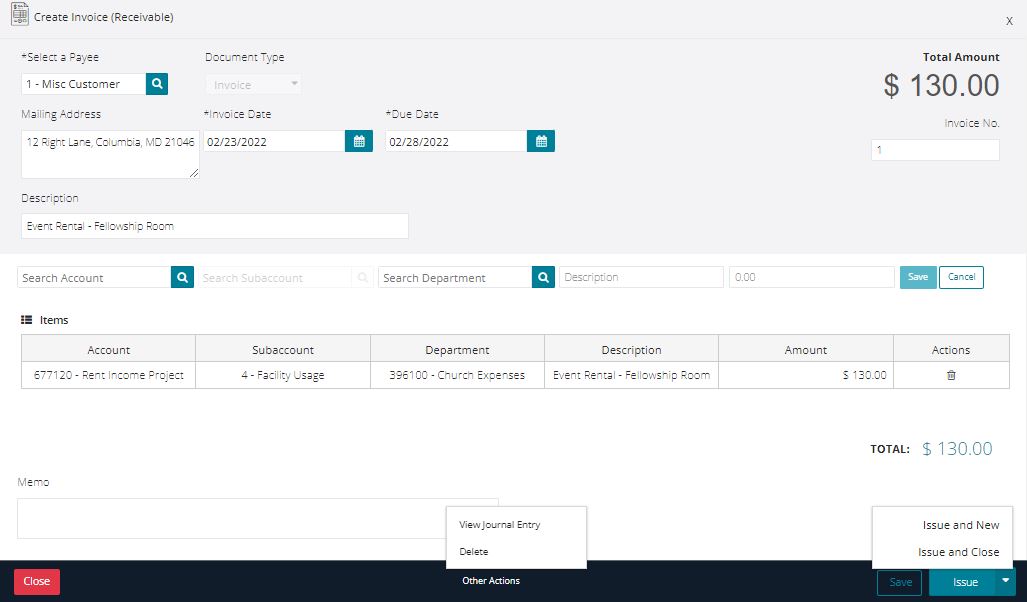

In the Add Receivable Credit screen, we will enter credits for an invoice which reduces the amount we are owed.

We will select the Payee (from a list of Customer, Employee, and Entity), populate a Date, and Description. The Ref No. will auto populate for us when the Receivable Credit is issued and can be left blank, but we can also override this field to assign a different Ref. number. We will also select the general ledger account to post to which would typically be an income account when we are issuing a receivable credit (an account that starts with a 6xxxxx or 7xxxxx) as this reduces the income amount we had originally invoiced, the sub-account (breakdown within the account like a bank, entity, or project for example), department, populate a description (which can be the same as the Description at the top of the screen or it can be different if needed or if there are multiple entries), and amount. The Save button after the amount saves the accounting entry and Cancel will clear the current accounting entry. Once the entry is saved, you can add more accounting entries if needed and we may do this if we want to split out the credits into separate income accounts or just to have them listed individually. There is a trash bin icon under the Actions column next to the accounting entry and this will allow us to delete the accounting entry. There is a Memo field at the bottom of the screen that can be used to add an additional note. In the Other Actions menu at the bottom of the screen, there is an option to “View Journal Entry” which will give us a printout of the entries related to the receivable credit being created, and we will see a “Delete” option which will allow us to delete the credit before it is finalized. We will use the “Issue and New” button if we are ready to finalize the credit, the system will save the credit entry, close the current receivable credit, and load a new screen to enter another credit. The “Issue and Close” button will save the receivable credit entry, close the current credit, and take us back into the main Payable and Receivable screen and the receivable credit should load in the grid view. The “Issue” button will save the credit entry but will leave the Receivable Credit screen open for the current credit and the “Save” button will save our work for the current credit entry without yet finalizing it and this will allow us to close the receivable credit screen and come back to edit it later. The “Close” button will close out of the receivable credit entry, but we would want to ensure that we save our work if needed otherwise any recent changes will be lost and the system will prompt us before closing if we are sure we want to close the current window. The system will save the entry we made to the income account in our example as a debit and internally it will make the appropriate offsetting credit entry on our behalf to the accounts receivable account based on the selected payee/subaccount (Customer, Employee, or Entity). Reference Transaction Config and see journal entry example below.
